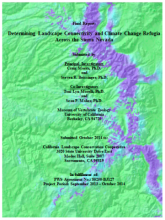Determining Landscape Connectivity and Climate Change Refugia Across the Sierra Nevada

Release of vast quantities of greenhouse gases into the atmosphere has increased annual mean temperatures, altered global precipitation, reduced polar ice caps, and changed plant composition. As California's climate rapidly changes, land managers need to know how species distributions might shift to design effective climate change adaptation strategies. Studies have begun to examine the effect of climate and land use change on Sierra Nevada birds and mammals. However, few studies have focused at a smaller scale to understand whether populations are connected across the expanse of the Sierra Nevada. Another mostly untested idea is the existence of climate change refugia, areas that are relatively buffered from climate change so as to increase persistence of valued physical, ecological, and social resources, such as cold air drainages where cooler areas can be found at lower elevations.
In this project, we sought to hypothesize which of the meadows across the Sierra Nevada were climate change refugia and what were their levels of connectivity. We then used data on persistence, stability, and genetic diversity of mammal populations to test these hypotheses. We addressed California Landscape Conservation Cooperative priorities of scale by analyzing across the Sierra Nevada. We involved state and federal natural resource managers and scientists to determine the scope in the beginning and throughout the project; some are already beginning to incorporate results. Our products focused on maps and products that are user-friendly and that allow managers to make decisions and set landscape conservation priorities. We communicated project outcomes directly to CA LCC partners to aid in decisions from immediate, small-scale adaptation projects to region-wide changes in use, development, and planning for state and federal land management. Our results will help managers to prioritize areas and landscapes that are critical to maintaining biodiversity in the Sierra Nevada in the face of climate change and to focus limited resources for effective adaptation efforts.
Moritz, C., S. R. Beissinger, T. L. Morelli, and S. P. Maher. 2014. Determining Landscape Connectivity and Climate Change Refugia Across the Sierra Nevada; Report to the California Landscape Conservation Cooperative. Museum of Vertebrate Zoology, UC Berkeley.
